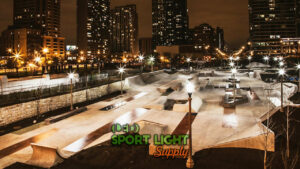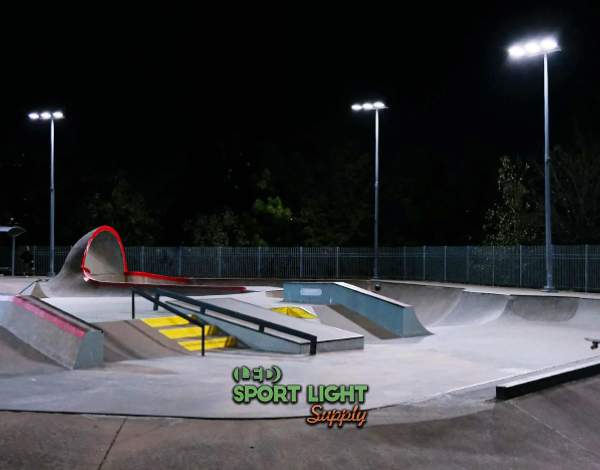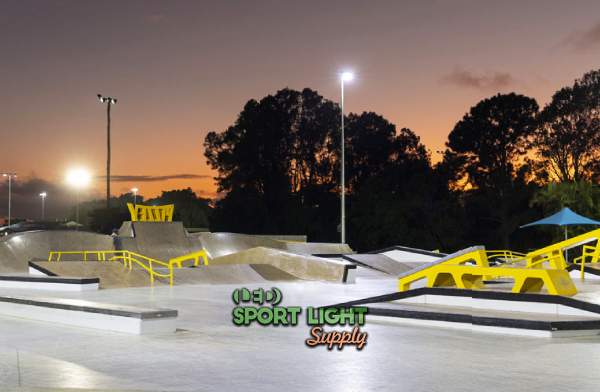
The transition to solar-powered lighting in skate parks is a step forward in sustainable urban design. As communities seek greener alternatives, solar-powered lighting systems offer a solution that benefits both the environment and the people who use these spaces. Solar panels, which convert sunlight into electricity, are combined with energy-efficient LED lighting to provide illumination that reduces reliance on conventional power sources. This approach not only lowers energy consumption but also decreases operational costs, all while contributing to the reduction of carbon emissions. Solar lighting helps to ensure that skate parks remain accessible and safe at night, creating a sustainable model for outdoor public spaces.
Table of Contents
Toggle Solar-powered lighting relies on solar panels to capture and convert sunlight into electricity. This electricity is stored in batteries that power the lights once the sun sets. Because the energy comes from the sun, there’s no need for external electricity sources, such as the local grid, to power the lighting. This setup reduces the carbon footprint of the skate park by eliminating the need for fossil fuels, which are commonly used to generate electricity. The use of solar energy also leads to significant cost savings over time. Without monthly electricity bills, park operators can reinvest savings into improving or expanding the park.
Solar-powered lighting relies on solar panels to capture and convert sunlight into electricity. This electricity is stored in batteries that power the lights once the sun sets. Because the energy comes from the sun, there’s no need for external electricity sources, such as the local grid, to power the lighting. This setup reduces the carbon footprint of the skate park by eliminating the need for fossil fuels, which are commonly used to generate electricity. The use of solar energy also leads to significant cost savings over time. Without monthly electricity bills, park operators can reinvest savings into improving or expanding the park.
LED lights are a crucial component of solar lighting systems. Their energy efficiency and long lifespan make them an ideal pairing with solar technology. Unlike incandescent or fluorescent lights, LEDs consume far less electricity, allowing solar-powered systems to operate effectively with the stored energy generated by the solar panels. This characteristic makes LEDs a natural fit for environments like skate parks, where lighting needs to be both reliable and sustainable.
One of the key benefits of LED lighting is its energy efficiency. LEDs use up to 80% less energy than traditional bulbs, meaning they provide the same amount of light while consuming much less power. This efficiency translates into longer operating hours, reduced energy consumption, and a smaller carbon footprint. With fewer resources required to power them, solar-powered LED lights are not only more affordable but also more environmentally responsible.
Another major advantage of LEDs is their longevity. Traditional lighting systems often require frequent replacements due to wear and tear, especially in outdoor environments. However, LEDs have an extended lifespan, often lasting up to 50,000 hours or more, which means less maintenance and fewer replacements. The durability of LEDs is particularly valuable in skate parks, where the lights are exposed to outdoor conditions year-round. With minimal maintenance needs, park operators can save on labor and replacement costs, making LED lighting a cost-effective long-term solution.
LED lights also perform well under a wide range of environmental conditions, from high temperatures to rain and snow. Since skate parks are typically outdoor spaces, the lighting systems must be resilient to these variables. LED fixtures produce less heat compared to incandescent bulbs, which enhances their efficiency and longevity, especially in hot climates. Furthermore, their ability to perform in freezing temperatures means they can provide consistent lighting in winter months without the risk of failure or reduced brightness. These attributes make LEDs a superior option for solar lighting systems that need to function reliably in diverse weather conditions.
 The design of a solar lighting system in a skate park goes beyond simply placing lights. To ensure the park remains well-lit throughout the night, the lighting system must be carefully planned and executed. Proper design helps ensure the lighting is bright enough to allow skaters to see clearly while also being positioned in a way that creates a safe and enjoyable environment.
The design of a solar lighting system in a skate park goes beyond simply placing lights. To ensure the park remains well-lit throughout the night, the lighting system must be carefully planned and executed. Proper design helps ensure the lighting is bright enough to allow skaters to see clearly while also being positioned in a way that creates a safe and enjoyable environment.
The arrangement of solar panels and LED lighting fixtures is crucial for maximizing the efficiency and effectiveness of the system. Solar panels should be installed in locations that receive the most sunlight during the day to ensure that they are able to generate enough energy to power the lights at night. It’s also important to place the panels in positions where they are less likely to be shaded by trees, buildings, or other structures, as this can reduce their ability to capture sunlight.
Once the solar panels are in place, the lighting fixtures must be positioned to provide adequate coverage across the entire skate park. The goal is to avoid dark spots that could create hazards for skaters. At the same time, the lights must be arranged to minimize glare, which could be disruptive to both skaters and the surrounding community. A well-designed system ensures the park is illuminated evenly, offering clear visibility for skaters and increasing safety for everyone using the space.
The quality of light produced by solar-powered LEDs is another factor to consider. Solar lighting systems should provide bright, uniform illumination that supports various activities within the park. From tricks and flips to casual skateboarding, the lighting needs to be adaptable to different levels of activity. The light should be bright enough to enhance visibility but not so harsh that it causes discomfort or interferes with the enjoyment of the space. Well-distributed light helps create a positive atmosphere and fosters a welcoming environment for skaters and visitors alike.
The durability of solar lighting systems is particularly important in locations where weather conditions vary throughout the year. Since skate parks are open-air venues, their lighting systems must be able to withstand extreme temperatures, heavy rainfall, snow, and even strong winds. Only high-quality materials and construction can ensure the lighting system continues to function throughout all seasons, providing consistent illumination without the need for frequent repairs or replacements.
To withstand the elements, solar panels and LED fixtures must be made from durable, weather-resistant materials. The use of high-quality aluminum, stainless steel, and specialized coatings helps protect the components from rust, corrosion, and physical damage. These coatings also protect the lights from UV rays, ensuring they maintain their brightness and performance even under prolonged exposure to the sun.
Advanced sealing technologies also help to prevent water and dust from entering the fixtures, which could otherwise cause damage. These weather-resistant features make solar-powered lighting systems suitable for areas with fluctuating climates, providing peace of mind for skate park operators who want to ensure the system works reliably, no matter the weather.
Solar-powered LED lighting systems offer both economic and environmental benefits. The most immediate financial benefit is the reduction in electricity costs. By using solar energy, skate parks no longer need to pay for electricity to power the lights. This translates into long-term savings, as solar panels can last for decades, with minimal maintenance and operational costs.
In addition to energy savings, solar-powered LED systems require less frequent maintenance than traditional lighting. LED bulbs last significantly longer than other types of bulbs, and because they are designed to be weather-resistant, they can operate efficiently without the need for constant repairs. Park operators benefit from fewer disruptions in service, as well as a reduction in the need for maintenance labor and replacement parts. This low-maintenance aspect of solar lighting is especially appealing for skate parks, which may not have the budget for regular upkeep.
From an environmental perspective, solar lighting contributes to global efforts to reduce carbon emissions and combat climate change. By relying on renewable solar energy, skate parks play a role in reducing the demand for fossil fuels. This shift to clean energy not only reduces greenhouse gas emissions but also helps to protect natural resources for future generations.
Beyond its technical and financial advantages, solar-powered lighting enhances the skate park’s role within the community. A well-lit skate park extends its hours of use, allowing skaters to enjoy the space in the evening. The presence of bright, dynamic lighting also encourages social interaction and community engagement, helping to create a vibrant, inclusive environment.
The lighting system itself can contribute to the park’s aesthetic appeal. Modern LED lights come in various colors and designs, which can be used to create an attractive ambiance. Lighting not only serves a functional purpose but also adds to the visual identity of the skate park, making it a more inviting space for people of all ages.
As communities increasingly prioritize sustainability, solar lighting serves as a symbol of innovation and forward-thinking. The integration of solar power into a public space reflects a commitment to both environmental responsibility and community well-being. Skate parks equipped with solar lighting become not just places to skate but symbols of local pride and environmental stewardship.
By embracing sustainable lighting solutions, skate parks contribute to the development of greener, more resilient communities, creating a lasting impact on both the local environment and the people who enjoy these spaces.
Solar-powered lighting systems in skate parks offer a sustainable, cost-effective, and environmentally friendly solution for illuminating public spaces. By harnessing solar energy and using energy-efficient LEDs, these systems reduce operational costs, minimize environmental impact, and provide reliable lighting year-round. The durability and low maintenance of solar-powered LED lights ensure long-term savings, while their ability to withstand various weather conditions makes them ideal for outdoor environments. Additionally, these lighting systems enhance the park’s aesthetic appeal and foster a sense of community, creating vibrant, inclusive spaces for all to enjoy.
Drop us a line to receive a free lighting design